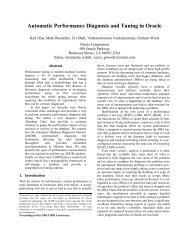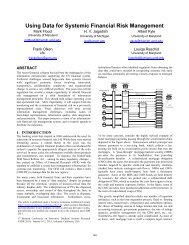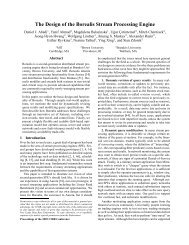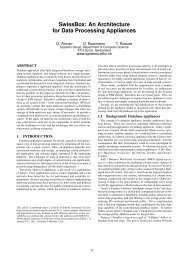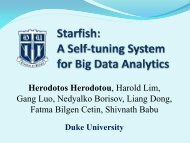Query Processing for Sensor Networks - CIDR
Query Processing for Sensor Networks - CIDR
Query Processing for Sensor Networks - CIDR
You also want an ePaper? Increase the reach of your titles
YUMPU automatically turns print PDFs into web optimized ePapers that Google loves.
on demand. Hybrid routing protocols, e.g. ZRP [11],<br />
combine both properties of proactive and reactive protocols.<br />
AODV is a typical reactive routing algorithm. It<br />
builds routes between nodes only as desired by the application<br />
layer. There are several reasons why we use<br />
AODV as the routing protocol <strong>for</strong> our study. First,<br />
reactive routing protocols scale to large-size networks,<br />
such as sensor network with thousands of nodes. Second,<br />
AODV does not generate duplicate data packets,<br />
which is a requirement to do in-network aggregation<br />
<strong>for</strong> duplicate-sensitive aggregate operators. Finally,<br />
AODV is a popular ad-hoc network routing protocol<br />
and it is implemented in several simulators. Although<br />
our discussion is based on AODV, our observations<br />
apply to other routing protocols as well.<br />
4.2 Extensions to the Network Interface<br />
Recall from Section 3 that we can optimize aggregate<br />
operators through in-network aggregation, such<br />
as packet merging and partial aggregation at internal<br />
nodes. These techniques require internal nodes to<br />
intercept data packets passing through them to per<strong>for</strong>m<br />
packet merging or partial aggregation. However,<br />
with the traditional “send and receive” interfaces of<br />
the network layer, only the leader will receive the data<br />
packets. The network layer on an internal node will<br />
automatically <strong>for</strong>ward the packages to the next hop towards<br />
the destination, and the upper layer is not aware<br />
of data packets traveling through the node. This functionality<br />
is sufficient <strong>for</strong> direct delivery of packets to<br />
a destination node, but to implement in-network aggregation,<br />
a node needs the capability to “intercept”<br />
packages that are not destined <strong>for</strong> itself; the query<br />
layer needs a way to communicate to the network layer<br />
which and when it wants to intercept packages that are<br />
destined <strong>for</strong> the leader [14].<br />
With filters [14], the network layer will first pass<br />
a package through a set of registered functions that<br />
can modify (and possibly even delete) the packet. In<br />
case of the query layer, if a node n is scheduled to<br />
aggregate data from all children nodes, it can intercept<br />
all data packets received from the children nodes<br />
and cache the aggregated result. At a specific time,<br />
n will generate a new data packet and send it to the<br />
leader. All this happens completely transparently to<br />
the network layer.<br />
4.3 Modifications to Wireless Routing Protocols<br />
Existing wireless routing protocols are not designed<br />
<strong>for</strong> the communication patterns exhibited by a query<br />
processing layer: they are designed <strong>for</strong> point-to-point<br />
communication, and are usually evaluated by selecting<br />
two random nodes and establishing and maintaining<br />
a communication path between them. A sensor<br />
network with a query layer has a significantly different<br />
communication pattern: Many source nodes send<br />
tuples to a common node, like a leader of an aggregation,<br />
or a gateway node. In addition, in a regular<br />
ad-hoc network, a node has no knowledge about the<br />
communication intents of neighboring nodes, whereas<br />
in a sensor network, data transfer to the leader node is<br />
usually synchronized to per<strong>for</strong>m aggregation. Thus a<br />
node can often estimate when neighboring nodes (such<br />
as children in a spanning tree) will send messages to<br />
it. We describe here a series of enhancements to one<br />
specific routing protocol, AODV [26], although we believe<br />
that our techniques are general enough to apply<br />
to any wireless routing protocol.<br />
Route initialization. Be<strong>for</strong>e sending data packets<br />
to the leader, each sensor has to establish a route<br />
to the leader, or determine who is the next hop in<br />
the DAG or spanning tree. Instead of initializing the<br />
route <strong>for</strong> each node separately from the source node<br />
as it would happen in AODV, we can create all the<br />
routes together by broadcasting a route initialization<br />
message originating at the leader of the aggregation.<br />
The message contains a hop count which is used <strong>for</strong><br />
nodes to determine their depth in the tree. Using this<br />
initial broadcast, nodes can save the reverse path as<br />
the route to the leader.<br />
Route maintenance. Reliability plays a very important<br />
role in in-network aggregation. Since each<br />
data packet contains an aggregate result from multiple<br />
sensor nodes, dropping a data packet, especially<br />
if near the leader, will seriously decrease the accuracy<br />
of the final result. The problem is more serious in sensor<br />
networks, in which link or node failures happens<br />
frequently. We describe two techniques that improve<br />
AODV in case of failures.<br />
Local Repair. In AODV, when a broken link is detected,<br />
the source node n broadcasts a request to find<br />
an alternative route. An internal node n ′ cannot reply<br />
to the request unless n ′ has a “fresher route” to the<br />
leader than n. The efficiency of the local repair algorithm<br />
depends on how fast a node can find an up-todate<br />
route in its neighborhood, and AODV uses a sequence<br />
number to reflect route “freshness”. Given that<br />
query processing has a very regular communication<br />
structure, in which many of nodes want to route packets<br />
to the same destination, we can extend AODV’s<br />
idea of a sequence number to repair broken routes more<br />
efficiently. Since a broken link has no effect on other<br />
nodes which are close to the leader, we integrate the<br />
depth of a node into the packet sequence number to<br />
differentiate sequence numbers between nodes that are<br />
spatially close. The new algorithm does not depend<br />
on the exact depth of a node to compute the new sequence<br />
number; a rough approximation that preserves<br />
relative depths is sufficient. Using an approximation<br />
to depth prevents a node from updating the depths of<br />
all nodes on the path to the leader after the broken



